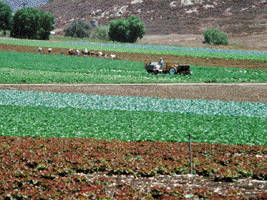Tools and Methods

Soil Management Techniques
In sustainable systems, the soil is viewed as a living medium that must be nurtured to ensure its long-term viability. Healthy soil, well managed for water and nutrients, produces healthy plants that are less susceptible to pests. Here are some of the many techniques that farmers might use to mange the soil sustainably.
- Using cover crops-Cover crops hold soil and nutrients in place. When mowed or left as a standing mulch, cover crops conserve soil moisture and increase water infiltration.
- Reducing run-off and erosion- Planting vegetation , using mulch and leaving crop residue helps hold soil in place and reduce runoff and erosion.
- Reducing soil compaction-Soil compaction is avoided by reducing the amount and timing of tillage. By reducing tillage, farmers also reduce their need for fossil fuels.
- Improving soil fertility-, Adding fertilizers and organic matter, such as compost and manure, to the soil increases diversity of soil microbial life.
- Managing Irrigation water efficiently- In Southern California our natural rainfall is inadequate to satisfy the needs of agricultural crops. Local growers can manage irrigation water efficiently using such methods as, using drip irrigation and low volume irrigation systems and selecting drought-tolerant crop varieties.
Crop Diversity
Farmers choose a variety of crops and methods to support the biological systems of a sustainable farm. Diversified farms are usually more economically and ecologically resilient. By growing a variety of crops, farmers spread economic risk and reduce the need for inputs of purchased pesticides and fertilizers. Crop rotation helps suppress weeds and pest infestations, and inhibits the growth of soil pathogens. Cover crops, in orchards and vineyards, buffer against pests by hosting beneficial insects that prey on pest species.
Natural Pest Control
Focus on using natural pest control options, rather than herbicides and pesticides. Many wildlife and insect species can serve as natural control for common pests of gardens and crops. Using good practices and designs that allow your garden or farm to work in conjuncture with natural processes and wildlife, rather than against it, leads to healthy soil, wildlife and people.

Prime Farmlands
An important component of sustainable communities is sustainable farmlands. People need fresh, healthy foods, and the most efficient way to produce food is to farm high quality, prime soils. Sustainable communities locate farmlands on their best soils, on the outskirts of urban areas to minimize product transportation and fossil fuel depletion. Sustainable agriculture rebuilds local food economies, shortening the distance food travel to the table. Currently, the average pound of food travels 1500 miles. Identical commodities pass each other in opposite directions, criss-crossing the globe due to current economic and political systems.

Locally, our highest quality soils for agricultural production are frequently the easiest, and least expensive to develop to urban uses. So to begin with, we are building over our best soil. Then, as farms move from deep, rich soils to marginal, lower quality soils, greater inputs are required to create productivity. Additionally, farming on sloping land requires greater expense for erosion control.
In California, we are expected to loose 100,000 acres of farmland each year as our population increases 50% by the year 2025. Through sustainable planning, Smart Growth communities direct development to preserve prime farmlands for best use of natural resources.


